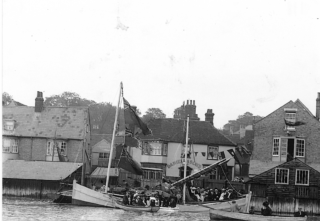About The Anchor Inn c.1684 to c.1911
Located on The Quay at the foot of Anchor Hill
Keith Bunting
The Pub Trail Index – click here
The Anchor was one of Wivenhoe’s earliest pubs. Its river Colne quayside setting was significant. In the 1800s, boat owners met their captains and public auctions of boats were common. A few landlords earned a living as oyster fishermen and many played a significant role in Wivenhoe society. The pub was one of many in Wivenhoe that closed in the early 1900s and no records after 1911 have been found.
First references to The Anchor
The first reference to The Anchor is in the 19 May 1684 will of innkeeper Henry Garland, who left his ‘ house called by the name of the Anchor and the other new house standing upon the premises‘ to his ‘loveing wife Sarah Garland’.
Usually called The Anchor Inn, some documents refer to it as The Anchor Hotel. Reference is made to a sale at The Blue Anchor pub in a 1758 ledger of Wivenhoe Contributions to the Poor which also says that in ‘1729 Chris Harvey was at The Anchor’. However, the first recorded landlord at The Anchor is William Hempsted, originally from Colchester, who lived at the pub from 1729 to 1773 with his wife Amy. The next recorded landlord was John Hempsted, who may have been William’s grandson.
Connection with Wivenhoe Baths
In 1777, Thomas Munning become landlord, probably relying on his wife, Rebecca to run the pub, as in the same year he became ‘Master of Wivenhoe Bath’. These therapeutic baths were located 100 metres from the pub at the quay end of Bath Street. According to Nicholas Butler’s book on Wivenhoe, Horace Flack opened the bath in about 1750 and it is mentioned that ‘Munnings was patronised by the first lady of the parish’. In 1781, whilst Abraham Brown or Broom was landlord, cockfighting took place at the pub.
Oysters
From 1846, 26 year old Charles Heath, was the first landlord at The Anchor described as an oyster merchant. Nick Butler in his book about Wivenhoe tells of an army platoon, who in 1861 reached amicable agreement with fishermen blocking them on Wivenhoe’s quayside after which they ‘all trooped down to The Anchor’ leaving at 5am, after Charles Heath had provided ‘Colchester natives’, oysters. Charles ran the pub for sixteen years, until 1862 and died in Wivenhoe in 1881, leaving his estate of ‘under £600′ to his wife Amelia. He was succeeded from 1865- 67 by his eldest son, William and from 1868-71 by his son in law, Henry TB Wood who in 1865 had married Charles’ eldest daughter Emma Elizabeth.
The Wivenhoe Earthquake
From 1883 to 1891 the pub was run by Dick Ham, described in Dick Barton’s book as ‘the burly auctioneer and undertaker’ and by Peter Kay as ‘leading Wivenhoe builder from the 1880s to the 1920s’. A number of Dick Ham’s family ran Wivenhoe pubs including Nathan Ham at The Falcon, Abraham Ham at The Greyhound, Robert Ham at The Sailors Return and William Ham at The Yachtsman. In 1884, the Essex earthquake affected The Anchor, Church, and many other quayside properties. Dick Ham told the Essex Standard newspaper that he was standing in the pub yard at about 9.20a.m and heard a tremendous noise, like the rushing in of an underground train. When he’d recovered he ‘was surrounded with the falling debris’. Peter Kay writes that The Anchor roof was ‘virtually unscathed, a testimony to well-fixed tiles of this type…capable of withstanding an earthquake.’ There are photos in Peter Kay’s book of the damage. In 1898 Dick Ham was elected to the first Wivenhoe Urban District Council. Documents show that after leaving the pub, he was a carpenter, builder and auctioneer/valuer, living until his death at The Firs, Wivenhoe on 8 October 1932. In his will he left £1,290.75 to his widow Mary and her father, law clerk, William Naylor.
Meetings and Auctions
In the late 1800s The Anchor was a popular place for meetings and auctions. At a lunch meeting in 1886, the boat owner of the Rosabelle, Theodore Pim, promised James Round M.P. and Captain Henry Harlowe to build his next yacht in Wivenhoe. The Anchor hosted sales of boats and other property, as did The Rose and Crown and custom house on The Quay.
Last Reference to The Anchor
No reference to The Anchor has been found after 1911, when the last recorded landlord was Isaac James Hook, originally from Hampshire. A year later the census shows him living at Hamilton Villas, New Town Field, Wivenhoe. Isaac died March 1927 in Winchester Hampshire and left £173.35 in his will.
Links to other pages on this website:
- The Will of Henry Garland, dated 19th May 1684, Inn keeper of The Falcon (transcribed by Pat Marsden)
- People who have lived at The Anchor Inn
- Auctions at the Anchor Inn in the 1800s
- About Wivenhoe pub signs by Keth Bunting
- About the filming of Plotlands in 1996
General Sources:
- Barton D, “Wivenhoe: its attractions, pleasures and eccentric natives”, Dick Barton Enterprises 1975.
- Butler N, “The Story of Wivenhoe”, Quentin Press Wivenhoe, 1989
- Church of England Parish Registers of Births & Baptisms, 1813-1918; Marriages, 1754-1935; Deaths & Burials, 1813-2003. Civil Registrations; Births England & Wales, 1837-1915; Marriages/Deaths 1837- 2007
- Directories: London – Kelly’s, Piggotts and UKPH 1828-1937 (1862, 1874 and 1878)
- Essex Standard (newspaper), Colchester, England, Edition 9 January 1984
- Kay P, “Wivenhoe and the Earthquake published by Peter Kay, 2005
- Kay P, “Wivenhoe Pubs”, published by Peter Kay 2003.
- National Probate Calendar (Index of Wills and Administrations) England & Wales, 1858-1966, 1973-1995.Kew, Public Record Office
- Rahim M, “Strike breaking in Essex”, Canary Press, 1985
- Thompson P, “Sea- Change, Wivenhoe Remembered” Tempus Publishing Ltd, 2006
The Pub Trail Index – click here













No Comments
Add a comment about this page